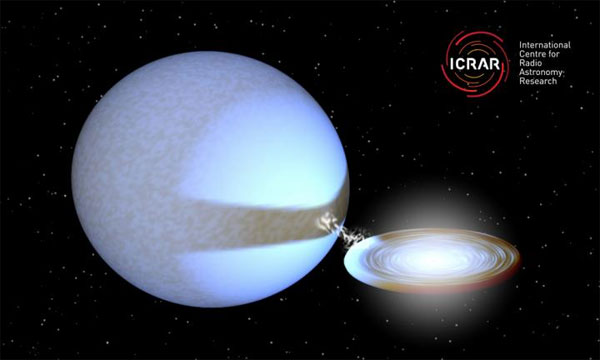Black hole detection
Astronomers have discovered a singular black hole, "gobbling up" gas from a nearby star at speeds 10 times faster than previously predicted.
>>>Does the hypothesis of a black hole exist?
>>> Discover the mystery of the most exotic black holes in the universe
The "hungry" black hole above has the nickname P13 , located in the outskirts of the galaxy NGC7793 , about 12 million light-years from Earth. The researchers found that the P13 black hole is absorbing a mass equivalent to 100 billion billion sausages per minute.
Dr Roberto Soria, an expert at the International Radio Astronomy Research Center (ICRAR), is working at ICRAR's facility at Curtin University (Australia), saying that because the gas is drawn towards a black hole, so it is very hot and bright. Scientists initially noticed P13 because it is much brighter than other black holes, but once thought that this black hole is simply larger than usual.

The P13 black hole is absorbing a mass equivalent to 100 billion billion sausages per minute.(Photo: ICRAR)
"We have long believed that the maximum speed for swallowing and producing the light of a black hole depends closely on its size. Therefore, it is easy to understand when people conclude, the P13 is big. more than the usual, less bright, black holes we observed in our galaxy - the Milky Way, " explains Dr. Soria.
When Mr. Soria and his colleagues from the University of Strasbourg (France) measured the mass of P13, they discovered that it was actually small in size, though brighter than the Sun at least 1 million times. Only then did the team realize just how large this black hole is absorbing a large amount of material.
According to expert Soria, P13 orbits around an ultra-massive "donated gas" star , which is 20 times heavier than our Sun. The scientists observed that one side of the star was always brighter than the other, because it was illuminated by X-rays emitted by the P13 black hole. Therefore, the star seems brighter or fainter when moving around P13.
This allowed the team to measure the time for the black hole and the "donor gas" to orbit each other (about 64 days) and model the velocity of those two bodies as well as the orbital shape of them.
- How to detect cosmic black holes
- Discovered the unknown type of black hole
- Discover the mystery of the most exotic black holes in the universe
- 740 million light years away is a completely different universe of black holes
- Discovering 'super black holes' is 12 times bigger than the Sun.
- Evidence of the power of black holes
- Video: Top 5 biggest black holes discovered by NASA in 2017
- Stunned to discover about black hole nozzles
- The galaxy's giant black hole
- The first time I took a picture of a black hole three million times bigger than Earth
- Monster black hole 'belching' twice after swallowing gas
- The first time a black hole was discovered, it swallowed a star
 Van Allen's belt and evidence that the Apollo 11 mission to the Moon was myth
Van Allen's belt and evidence that the Apollo 11 mission to the Moon was myth The levels of civilization in the universe (Kardashev scale)
The levels of civilization in the universe (Kardashev scale) Today Mars, the sun and the Earth are aligned
Today Mars, the sun and the Earth are aligned The Amazon owner announced a secret plan to build a space base for thousands of people
The Amazon owner announced a secret plan to build a space base for thousands of people